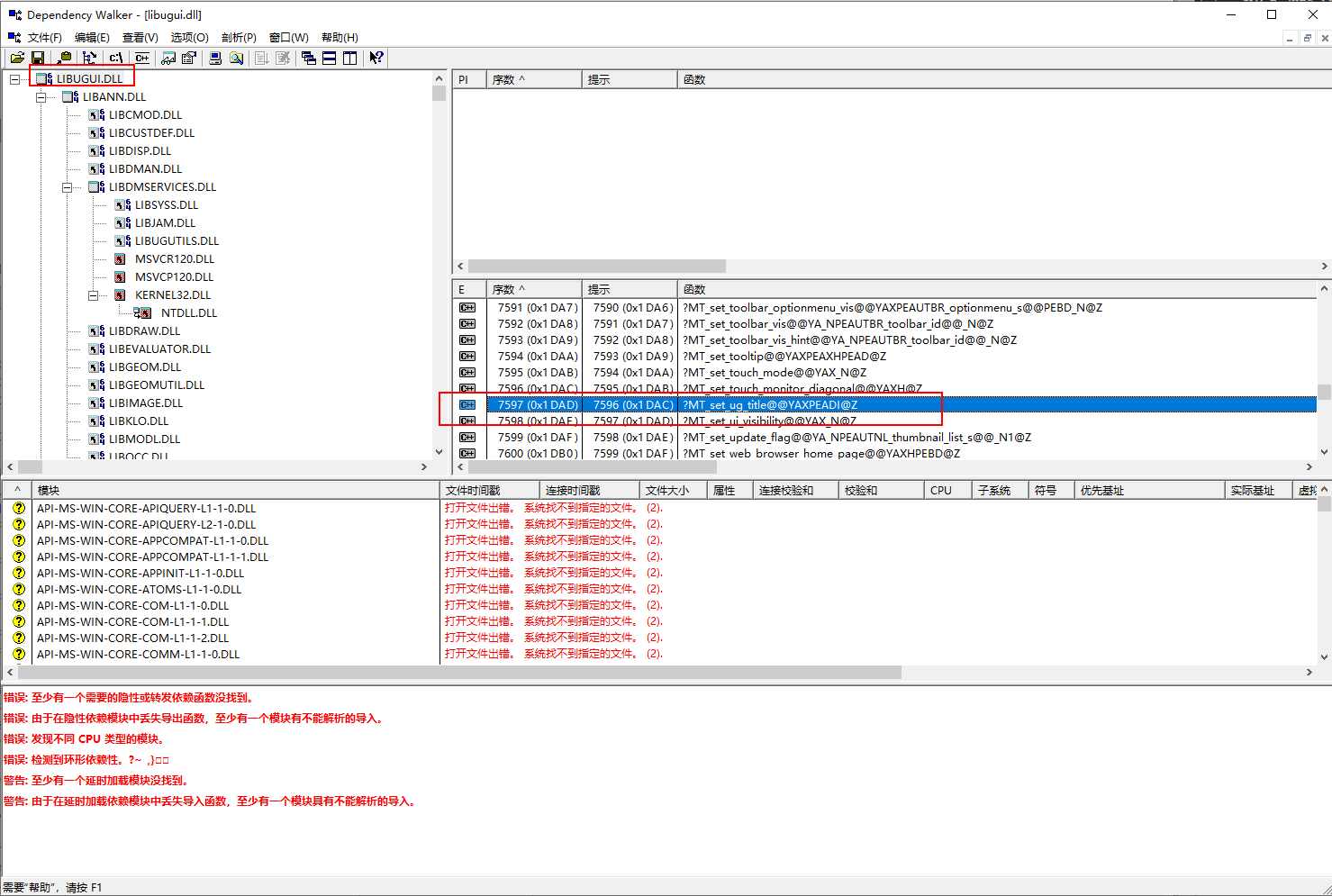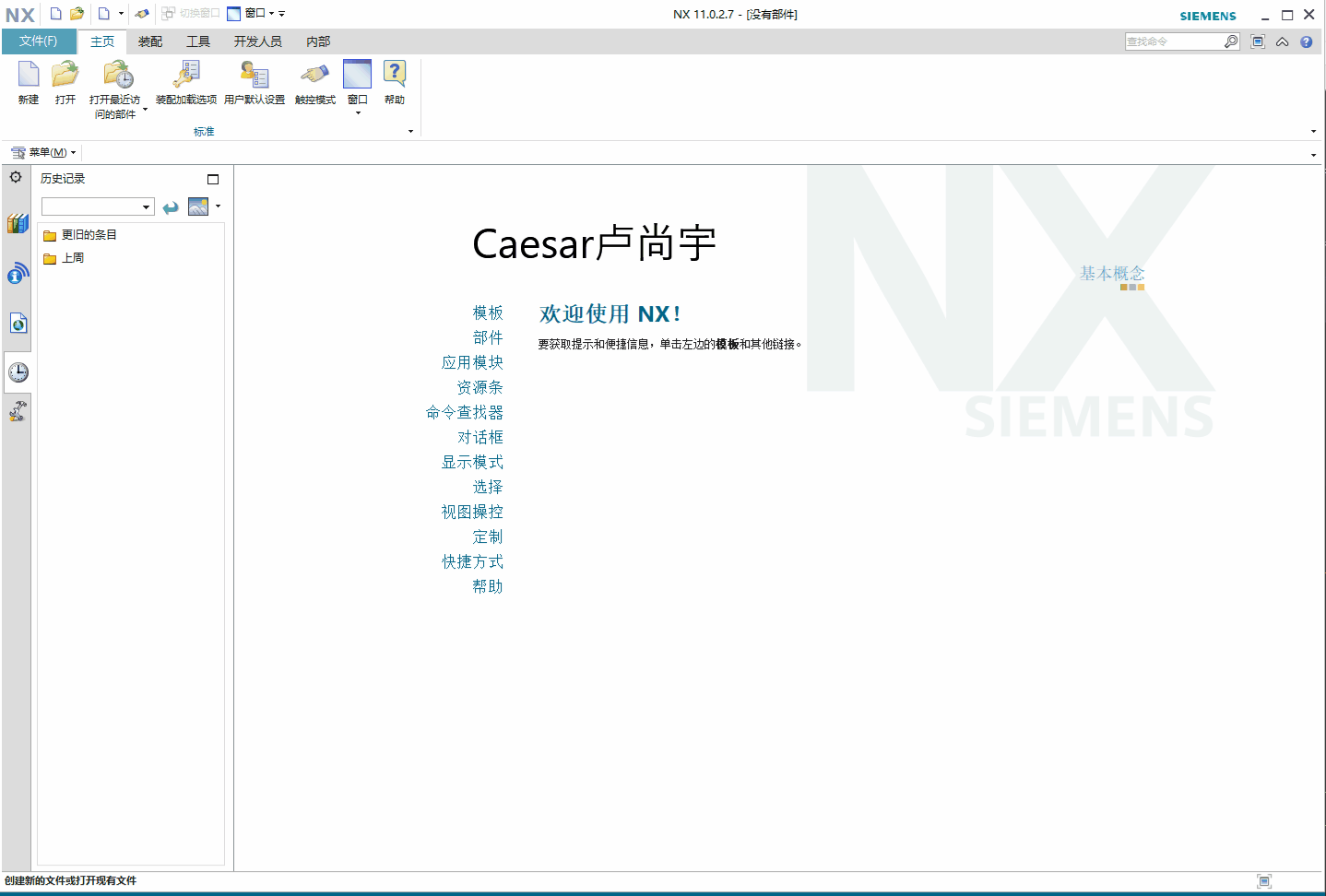三部曲:
NX二次开发-C#使用DllImport调用libufun.dll里的UF函数(反编译.net.dll)调用loop等UF函数(三部曲1)
NX二次开发-C#使用DllImport调用libufun.dll里的UF函数学习方法及tag转handle例子(三部曲2)
NX二次开发-C#使用DllImport调用libugui.dll里的内部函数自动将NX标题设置为prt路径例子(三部曲3)
在看完三部曲1和三部曲2后,我们来个更有意思的玩法,去调内部函数。
做NX二次开发,西门子官方开放给了我们API,但也有一些是他们内部用的函数,并没有开放给我们(比如关于NX窗口界面相关的等等)。
这个时候我们如果有相关的需求了怎么办?怎么去查找有哪些内部函数?怎么去调用函数?
这一讲就会介绍。
1.又是有需求
以前经常看到别人问怎么 自动将NX标题设置为prt路径,最开始我不会,后来七少兄弟很早之前教过我,他是用获取窗口NX标题句柄,然后修改标题内容,在加上计时器去做的。
我感觉好像别人也应该是这样做的。
今天我写一下调内部函数的方法,去设置NX标题。
2.反编译libugui.dll
首先用Depends.exe去反编译libugui.dll找到内部函数的入口。
内部函数具体用哪个得慢慢去找。找到了还得去猜函数的输入输出类型怎么定义。蛮难使用的。能搞清楚怎么用得,应该也就那么几个。
因为不像UF有明确的帮助说明,参数定义介绍。这里只介绍方法,具体有兴趣和需求的,你们可以自己去慢慢研究。
找到这个内部函数"?MT_set_ug_title@@YAXPEADI@Z",我猜测只有一个输入参数,结果被我猜中了。给一个输入参数是可以用的。

3.我们的项目
去项目中调用
[DllImport("libugui.dll", CallingConvention = CallingConvention.Cdecl, CharSet = CharSet.Ansi, EntryPoint = "?MT_set_ug_title@@YAXPEADI@Z")] internal unsafe static extern int _SetUgTitle(string title); public unsafe static void SetUgTitle(string title) { NXOpen.Utilities.JAM.StartUFCall(); OpenAPI._SetUgTitle(title); NXOpen.Utilities.JAM.EndUFCall(); }
要测试这个,我们还需要做三步操作。
1.加一个计时器,不断去刷新NX标题。
2.更改卸载方式,不要立即卸载,改完关闭NX卸载。
3.想要每次打开NX就默认加载,就把dll程序放到startup里(这一步好像有问题,用C+做,用ufsta入口没问题.C#的main入口,好像不能默认加载进来)。
以下为项目代码
using System; using NXOpen; using NXOpen.UF; using NXOpen.Utilities; using System.Runtime.InteropServices;//DllImport的命名空间 using System.Timers;//计时器 public class OpenAPI { [DllImport("libugui.dll", CallingConvention = CallingConvention.Cdecl, CharSet = CharSet.Ansi, EntryPoint = "?MT_set_ug_title@@YAXPEADI@Z")] internal unsafe static extern int _SetUgTitle(string title); public unsafe static void SetUgTitle(string title) { NXOpen.Utilities.JAM.StartUFCall(); OpenAPI._SetUgTitle(title); NXOpen.Utilities.JAM.EndUFCall(); } } public class Program { // class members private static Session theSession; private static UI theUI; private static UFSession theUfSession; public static Program theProgram; public static bool isDisposeCalled; //------------------------------------------------------------------------------ // Constructor //------------------------------------------------------------------------------ public Program() { try { theSession = Session.GetSession(); theUI = UI.GetUI(); theUfSession = UFSession.GetUFSession(); isDisposeCalled = false; } catch (NXOpen.NXException ex) { // ---- Enter your exception handling code here ----- // UI.GetUI().NXMessageBox.Show("Message", NXMessageBox.DialogType.Error, ex.Message); } } static void TimerUp(object sender, System.Timers.ElapsedEventArgs e) { //获得prt路径 string PrtPath = ""; theUfSession.Part.AskPartName(theSession.Parts.Display.Tag, out PrtPath); //设置NX标题 OpenAPI.SetUgTitle(PrtPath); } //------------------------------------------------------------------------------ // Explicit Activation // This entry point is used to activate the application explicitly //------------------------------------------------------------------------------ public static int Main(string[] args) { int retValue = 0; try { theProgram = new Program(); //TODO: Add your application code here Timer timer1 = new Timer(500); //设置执行一次(false)还是一直执行(true) timer1.AutoReset = true; //设置是否执行System.Timers.Timer.Elapsed事件 timer1.Enabled = true; //绑定Elapsed事件 timer1.Elapsed += new System.Timers.ElapsedEventHandler(TimerUp); theProgram.Dispose(); } catch (NXOpen.NXException ex) { // ---- Enter your exception handling code here ----- } return retValue; } //------------------------------------------------------------------------------ // Following method disposes all the class members //------------------------------------------------------------------------------ public void Dispose() { try { if (isDisposeCalled == false) { //TODO: Add your application code here } isDisposeCalled = true; } catch (NXOpen.NXException ex) { // ---- Enter your exception handling code here ----- } } public static int GetUnloadOption(string arg) { //Unloads the image explicitly, via an unload dialog //return System.Convert.ToInt32(Session.LibraryUnloadOption.Explicitly); //Unloads the image immediately after execution within NX //return System.Convert.ToInt32(Session.LibraryUnloadOption.Immediately); //Unloads the image when the NX session terminates return System.Convert.ToInt32(Session.LibraryUnloadOption.AtTermination);//使用这种卸载方式 } } Caesar卢尚宇 2020年9月30日

4.附件参考
在附加一个调宏的内部函数
[DllImport("libugui.dll", CallingConvention = CallingConvention.Cdecl, CharSet = CharSet.Ansi, EntryPoint = "?MACRO_playback_from_usertool@@YAXPEBD@Z")] internal unsafe static extern int _CallMacro(string path); public unsafe static void CallMacro(string path) { NXOpen.Utilities.JAM.StartUFCall(); OpenAPI._CallMacro(path); NXOpen.Utilities.JAM.EndUFCall(); }
到这里三部曲就正式结束,写完了。
Caesar卢尚宇
2020年9月30日